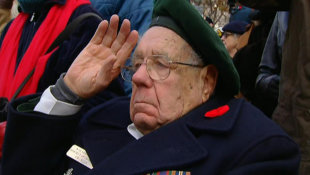
I saw my first white poppy earlier this week, on the lapel of a woman walking past the coffee shop where I was having lunch.
The Royal Canadian Legion's annual poppy campaign is in full swing as we head towards Remembrance Day on Monday, and almost every year there's a small but visible effort to distribute the white poppy, a longstanding expression of anti-war sentiment.
The white poppy campaign once again has drawn the predictable outrage from those who see it as misguided and disrespectful. There may be some truth in that.
"Young people don't want to celebrate war," Celyn Dufay of the University of Ottawa told as he and a group of fellow students launched a campaign to distribute white poppies. "We want to work for peace."
All wrong, Bill Maxwell said.
"The red poppy is a symbol of sacrifice," Maxwell, the legion's poppy remembrance committee secretary, told QMI Agency. "It's not a glorification of war." [ Related: Peace-oriented white poppy campaign keeps low profile as Remembrance Day nears ]
Veterans Affairs Minister Julian Fantino, whose department is under fire from critics over everything from stingy disability payments to rejecting requests to help bury impoverished vets, also sniffed at the pacifist poppy.
"It really does show a total lack of respect for what, in fact, Remembrance Day stands for," Fantino said Tuesday, according to . "And to try and intervene in this fashion, I think, is totally disrespectful, and I would suspect that most reasonable Canadians would see it that way."
The white poppy has been around almost as long as the red, which was first adopted as a symbol of remembrance in 1921. After British pacifists failed to convince the British Legion to print a peace message on the red poppy, the Women's Co-operative Guild began producing white poppies in 1933 as storm clouds once again gathered over Europe.
"The white poppy was not intended as an insult to those who died in the First World War - a war in which many of the white poppy supporters lost husbands, brothers, sons and lovers - but a challenge to the continuing drive to war," explains the British Peace Pledge Union.
Whatever the intention, many perceive the white poppy's appearance at this time as disrespectful distraction from the focus on past sacrifices made in the name of peace.
"The red poppy is inherently a symbol of peace," columnist Matt Gurney wrote Wednesday in National Post. "Not just of peace as a concept - pleasant a concept as it is - but as the hard-won peace that hundreds of thousands of Canadians, and our allies, earned at such great cost . . ."
"Poppies are not a symbol of military conquest and national glory; indeed, they are not a symbol of any nation at all." [ Related: Five reasons to wear a Remembrance Day poppy ]
The white poppy campaign's Facebook page drew support for the effort but also angry reaction.
"Understand, the RED poppy stands for the SACRIFICE of good men and women, so that even the ignorant, such as yourself can voice your opinions freely, pick a different day to push your ideology, let us honor the ones who died for us with respect, all should know there is no glory in war and death," Rod Stiebel commented.
There's probably some merit in moving the campaign away from Remembrance Day. Someone on Facebook suggested Sept. 21, World Peace Day, which is recognized by the United Nations.
But it's unlikely white poppy campaigners will want to lose the bump in visibility they get from the annual Remembrance Day period. And to be fair, they're not the only ones who exploit it. I've seen corporate good-guy ads with Remembrance Day themes in the past, and we seem to get a lot of war movies on TV.
But as one veteran in the QMI story's comment thread noted, soldiers served to protect the right of people to distribute white poppies, however we may feel about it.
0 comments Blogger 0 Facebook
Post a Comment